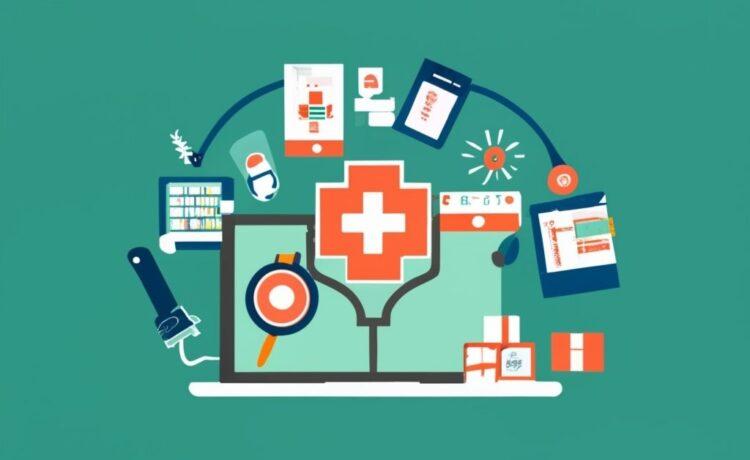Introduction
In the complex and dynamic world of healthcare, supply chain management is pivotal in ensuring that medical facilities operate efficiently and effectively. However, managing the supply chain in healthcare presents unique challenges, such as maintaining the availability of critical supplies, dealing with regulatory compliance, and managing costs amidst ever-evolving medical demands. These challenges can lead to disruptions in patient care, inefficiencies, and increased operational costs.
Streamlining supply chain operations is essential for overcoming these obstacles and enhancing healthcare delivery. By optimizing supply chain processes, healthcare providers can ensure timely access to necessary medical supplies, reduce waste, and improve patient outcomes. Efficient supply chain management enhances operational efficiency and contributes to the overall quality of care, making it a critical focus for modern healthcare systems aiming to deliver superior patient experiences and outcomes.
Understanding healthcare supply chain management
Healthcare supply chain management (HSCM) refers to coordinating and overseeing the flow of medical goods, services, and information from suppliers to patients. This comprehensive process encompasses procuring, storing, and distributing essential medical supplies, pharmaceuticals, medical devices, and equipment. Effective HSCM ensures that the right products are available at the right time and place, enhancing patient care and operational efficiency.
The main components of healthcare supply chain management include:
- Procurement – Acquiring medical supplies, equipment, and services from external suppliers. This involves sourcing, negotiating contracts, and ensuring compliance with regulatory standards.
- Inventory management – The tracking and controlling of medical supplies and equipment to maintain optimal stock levels, prevent shortages, and reduce waste.
- Logistics and distribution – The transportation and delivery of medical goods from suppliers to healthcare facilities, ensuring timely and secure movement through various supply chain stages.
- Information systems – Using technology and software to manage and streamline supply chain processes, providing real-time data and analytics for better decision-making.
- Regulatory compliance – Adhering to healthcare regulations and standards to ensure the safety and efficacy of medical products and the integrity of supply chain operations.
- Supplier relationship management – Building and maintaining strong partnerships with suppliers to ensure a reliable and high-quality supply of medical goods and services.
Key stakeholders involved in the healthcare supply chain
The healthcare supply chain involves a diverse group of stakeholders, each playing a critical role in ensuring the smooth operation and efficiency of the supply chain. Key stakeholders include:
- Suppliers and manufacturers – Entities that produce and provide medical supplies, equipment, pharmaceuticals, and other healthcare products. They are responsible for ensuring the quality and availability of products.
- Healthcare providers – Hospitals, clinics, pharmacies, and other healthcare facilities that require a steady supply of medical goods and services to deliver patient care.
- Distributors and wholesalers – Intermediaries that purchase medical supplies in bulk from manufacturers and distribute them to healthcare providers. They play a crucial role in logistics and inventory management.
- Pharmacy Benefit Managers (PBMs) – Organizations that manage prescription drug benefits on behalf of health insurers, ensuring the availability and cost-effectiveness of medications.
- Regulatory agencies – Government bodies that establish and enforce regulations and standards for the healthcare industry to ensure safety, efficacy, and compliance.
- Patients – The end recipients of healthcare services and products. Patient needs and outcomes drive the demand and priorities within the healthcare supply chain.
- Payers – Insurance companies, government programs, and other entities that finance healthcare services. They influence purchasing decisions and cost management within the supply chain.
- Technology providers – Companies that offer software and technological solutions to enhance supply chain management, including inventory tracking, data analytics, and communication systems.
Understanding the definition, components, and key stakeholders of healthcare supply chain management is essential for grasping the complexities and importance of this vital aspect of modern healthcare. Healthcare providers can achieve greater efficiency, cost savings, and improved patient outcomes by addressing the challenges and streamlining operations.
Benefits of streamlining supply chain management in healthcare
Streamlining supply chain management in healthcare brings numerous benefits that can significantly enhance the overall performance of healthcare systems. Key advantages include improved efficiency, reduced operational costs, enhanced patient care and safety, and better inventory management with reduced waste.
Improved efficiency and reduced operational costs
One of the primary benefits of streamlining supply chain management is enhancing operational efficiency. Healthcare facilities can minimize delays, reduce redundancies, and eliminate bottlenecks by optimizing procurement processes, logistics, and inventory management. This increased efficiency translates into substantial cost savings as resources are utilized more effectively and waste is minimized. Automated systems and advanced analytics enable healthcare providers to make data-driven decisions, reducing the likelihood of overstocking or stockouts, and ensuring that funds are allocated appropriately.
Enhanced patient care and safety through timely delivery of medical supplies
A well-optimized supply chain ensures that essential medical supplies and equipment are available when and where they are needed. Timely delivery of medical products is crucial for patient care, as delays can compromise treatment outcomes and patient safety. By streamlining supply chain processes, healthcare providers can avoid critical shortages, ensure the availability of high-quality medical products, and respond promptly to patient needs. This reliability and responsiveness contribute to improved patient outcomes and enhance the overall quality of care.
Better inventory management and reduced waste
Effective inventory management is a cornerstone of streamlined supply chain operations. By implementing advanced tracking systems and data analytics, healthcare facilities can maintain optimal inventory levels, preventing both shortages and excess stock. This balance reduces waste due to expired or obsolete products, which can significantly burden healthcare organizations. Better inventory management also allows for more accurate forecasting and planning, ensuring that resources are aligned with actual demand. This efficiency conserves financial resources and promotes sustainability by minimizing unnecessary waste.
Challenges in healthcare supply chain management
Despite the significant benefits of streamlining supply chain management, healthcare systems face numerous challenges that complicate these efforts. Key challenges include the complexity of healthcare logistics and procurement, data management and integration issues, and regulatory compliance coupled with the need for supply chain transparency.
Complexity of healthcare logistics and procurement
The logistics and procurement processes in healthcare are inherently complex due to the vast array of medical supplies, pharmaceuticals, and equipment required to meet diverse patient needs. Each item has unique handling, storage, and transportation requirements, often with strict temperature control and expiration date considerations. Coordinating the timely delivery of these varied items across multiple locations while managing vendor relationships and negotiating contracts, adds to this complexity. Furthermore, the unpredictable nature of medical demand, driven by disease outbreaks or natural disasters, necessitates a highly responsive and flexible supply chain.
Data management and integration issues
Effective supply chain management relies heavily on accurate and timely data. However, healthcare organizations often face challenges related to data management and integration. Disparate information systems, lack of standardization, and siloed data can hinder the seamless flow of information across the supply chain. This fragmentation leads to inefficiencies, such as duplicated efforts, errors in inventory levels, and delayed decision-making. Integrating various data sources, ensuring data accuracy, and implementing advanced analytics tools are essential yet challenging tasks that healthcare providers must address to achieve a streamlined supply chain.
Regulatory compliance and ensuring supply chain transparency
The healthcare industry is highly regulated to ensure patient safety and the efficacy of medical products. Compliance with these regulations is a critical challenge in supply chain management. Healthcare organizations must adhere to stringent guidelines set by regulatory bodies, which govern everything from procurement and storage to transportation and distribution. Ensuring compliance requires robust tracking and documentation systems, frequent audits, and continuous monitoring. Additionally, maintaining transparency throughout the supply chain is vital for building trust and accountability. This includes traceability of products from manufacturers to patients, managing recalls effectively, and safeguarding against counterfeit products.
Best practices for optimizing healthcare supply chain
Optimizing the healthcare supply chain is crucial for enhancing operational efficiency, reducing costs, and improving patient outcomes. Adopting best practices that leverage advanced technologies, data analytics, and collaborative efforts can significantly streamline supply chain processes. Key best practices include implementing advanced technologies like AI and IoT, utilizing data analytics for better decision-making, enhancing collaboration between stakeholders, and adopting automated inventory management systems.
Implementing advanced technologies like AI and IoT
Advanced technologies such as Artificial Intelligence (AI) and the Internet of Things (IoT) have the potential to revolutionize healthcare supply chain management. AI can be used to predict demand, optimize procurement processes, and identify patterns that help in strategic planning. Machine learning algorithms can analyze historical data to forecast future needs, reducing the risk of shortages or overstocking. IoT devices, such as smart sensors and RFID tags, enable real-time tracking of medical supplies, monitoring environmental conditions, and ensuring the integrity of sensitive products. Incorporating these technologies into healthcare custom software development enhance visibility and control throughout the supply chain, improving efficiency and reducing errors.
Utilizing data analytics for better decision-making
Data analytics is a powerful tool for improving decision-making in healthcare supply chain management. By analyzing large volumes of data from various sources, healthcare organizations can gain valuable insights into supply chain performance, identify trends, and make informed decisions. Predictive analytics can help anticipate demand fluctuations, optimize inventory levels, and manage supplier relationships more effectively. Data-driven insights enable healthcare providers to identify inefficiencies, streamline processes, and implement evidence-based strategies that enhance overall supply chain performance.
Enhancing collaboration between stakeholders
Effective collaboration between all stakeholders in the healthcare supply chain is essential for optimizing operations. This includes suppliers, manufacturers, distributors, healthcare providers, and regulatory bodies. Establishing strong partnerships and open communication channels fosters a collaborative environment where information is shared transparently, and challenges are addressed collectively. Collaborative platforms and integrated supply chain management systems can facilitate real-time information exchange, coordination of activities, and alignment of goals. Enhanced collaboration ensures that all parties are working towards common objectives, improving overall supply chain efficiency and resilience.
Adopting automated inventory management systems
Automated inventory management systems play a crucial role in optimizing healthcare supply chains. These systems use technologies such as barcode scanning, RFID, and IoT to track inventory levels, monitor stock movements, and manage replenishment processes. Automation reduces manual errors, enhances accuracy, and ensures that inventory data is always up-to-date. With automated systems, healthcare providers can maintain optimal stock levels, prevent shortages, and minimize waste. Additionally, automated inventory management allows for better forecasting and planning, ensuring that resources are allocated efficiently and effectively.
Future trends in healthcare supply chain management
As healthcare continues to evolve, the supply chain management sector is poised for significant advancements driven by emerging technologies and digital transformation. Understanding these future trends can help healthcare organizations stay ahead and optimize their supply chain operations for improved efficiency and patient outcomes.
Emerging technologies and innovations
Emerging technologies are set to revolutionize healthcare supply chain management, bringing unprecedented efficiency, accuracy, and visibility. Key innovations include:
- Blockchain technology – Blockchain offers a secure, transparent, and immutable ledger for tracking products throughout the supply chain. This technology can enhance traceability, prevent counterfeit products, and ensure regulatory compliance by providing a tamper-proof record of transactions and product movements.
- Artificial Intelligence (AI) and Machine Learning (ML) – AI and ML can analyze vast amounts of data to predict demand, optimize inventory levels, and improve procurement processes. These technologies enable predictive maintenance of equipment, risk assessment, and dynamic supply chain adjustments based on real-time data.
- Internet of Things (IoT) – IoT devices, such as smart sensors and RFID tags, provide real-time monitoring of inventory, environmental conditions, and equipment status. These devices enhance visibility and control over the supply chain, ensuring the integrity and timely delivery of medical products.
- 3D printing – 3D printing technology allows for on-demand production of medical devices, prosthetics, and even pharmaceuticals. This capability can reduce lead times, lower inventory costs, and enable customization of medical products to meet specific patient needs.
- Robotic Process Automation (RPA) – RPA can automate repetitive and time-consuming tasks, such as order processing, invoicing, and data entry. This automation reduces errors, speeds up processes, and frees up staff to focus on more strategic activities.
The role of digital transformation in supply chain optimization
Digital transformation plays a critical role in optimizing healthcare supply chain management by integrating advanced technologies and data-driven approaches into existing processes. Key aspects include:
- Data integration and analytics – Digital transformation enables the integration of data from various sources, providing a comprehensive view of the supply chain. Advanced analytics tools can process this data to generate actionable insights, improve decision-making, and enhance supply chain resilience.
- Cloud computing – Cloud-based platforms offer scalable and flexible solutions for managing supply chain operations. These platforms facilitate real-time collaboration, data sharing, and communication among stakeholders, ensuring seamless coordination and faster response times.
- Enhanced cybersecurity – As digital transformation increases reliance on technology, ensuring robust cybersecurity measures becomes crucial. Protecting sensitive data, securing supply chain networks, and preventing cyber threats are essential for maintaining the integrity and reliability of supply chain operations.
- Digital twins – Digital twin technology creates virtual replicas of physical supply chain processes and assets. These digital models can simulate various scenarios, predict outcomes, and identify potential issues, enabling proactive supply chain management and optimization.
- Telehealth and remote monitoring – The rise of custom software development for healthcare like telehealth and remote patient monitoring generates new demands on the supply chain, requiring efficient distribution of medical devices and home-based healthcare products. Digital transformation supports these needs by optimizing logistics and ensuring timely delivery.
Conclusion
Streamlining supply chain management in healthcare is imperative for enhancing operational efficiency, reducing costs, and improving patient outcomes. By leveraging advanced technologies like AI, IoT, and blockchain and embracing digital transformation, healthcare organizations can overcome the complexities of logistics and procurement, optimize inventory management, and ensure regulatory compliance. Effective collaboration among stakeholders and adopting automated systems further contribute to a more responsive and resilient supply chain. As the healthcare landscape evolves, prioritizing supply chain optimization will be crucial in delivering high-quality, timely, and cost-effective care to patients.
People Also Ask (PAA) questions
- What are the benefits of supply chain management in healthcare?
Supply chain management in healthcare improves operational efficiency, reduces costs, ensures timely delivery of medical supplies, and enhances patient care and safety.
- How can healthcare supply chains be optimized?
Healthcare supply chains can be optimized by implementing advanced technologies like AI and IoT, utilizing data analytics, enhancing stakeholder collaboration, and adopting automated inventory management systems.
- What are the common challenges in healthcare supply chain management?
Common challenges include the complexity of logistics and procurement, data management and integration issues, and ensuring regulatory compliance and transparency.
- What technologies are used in healthcare supply chain management?
Technologies used include AI, IoT, blockchain, 3D printing, and robotic process automation (RPA) for improved efficiency, visibility, and accuracy.
- How does supply chain management affect patient care in healthcare?
Effective supply chain management ensures the timely availability of medical supplies, reduces delays, and enhances patient safety and outcomes.
- What are best practices for healthcare supply chain management?
Best practices include implementing advanced technologies, utilizing data analytics, enhancing stakeholder collaboration, and adopting automated inventory management systems.
- How can data analytics improve healthcare supply chains?
Data analytics can improve demand forecasting, optimize inventory levels, enhance decision-making, and identify inefficiencies for better supply chain performance.
- What is the future of supply chain management in healthcare?
The future involves greater integration of emerging technologies like AI, IoT, and blockchain, and a continued focus on digital transformation for enhanced efficiency and patient care.
- How do hospitals manage their supply chain?
Hospitals manage their supply chain by coordinating procurement, logistics, inventory management, and compliance with regulatory standards, often using advanced technologies and data-driven approaches.
- What are the key components of a healthcare supply chain?
Key components include procurement, inventory management, logistics and distribution, information systems, regulatory compliance, and supplier relationship management.







